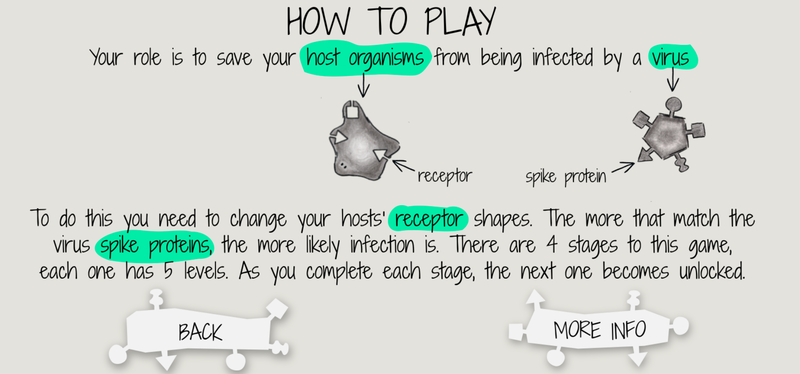Viruscraft II

Working with Dr Ben Ashby at the University of Bath, we've been building on our original Viruscraft project to make the all new Viruscraft II. This formed part of Ben's public engagement as part of his NERC funded Independent Research Fellowship, and will be used by Ben for teaching in schools and for events.
The original Viruscraft game was about understanding how viruses jump between different host species - for the new version the focus shifted to understanding how viruses and hosts co-evolve. Our original ambitions were to simplify the game world, and make a multi-location installation so that, for example, one person could be playing as the virus in one location while someone in another location would play as the host species, or we could send out multiple playable viruses to allow people to work together in a single online game world.
The development process started shortly before the pandemic - so shared, touchable viruses became untenable. We also had to start thinking much more about how people would feel when they were playing, as it was all suddenly much more real for everyone.
We shifted gears and decided to make a single robotic virus, that would automatically evolve to have different protein spikes. There would be an online game world full of small blob-like creatures, which the player was responsible for keeping alive as the virus evolved. As the player evolves their creatures to evade the virus, the robotic virus automatically evolves to be able to infect the new creatures, so the player learns about the constant processes of co-evolution. The player needs to watch the robotic virus carefully, moving around the physical installation to see how it is evolving, and respond quickly to evolve their creatures to avoid getting infected.
To make the game hands-off, the player evolves their creatures by waving hands over different shaped boxes, which contain gesture sensors to detect the players' movement. Waving a hand over a shape selects that shape, and gradually the creatures in the game evolve to have that shape.
Put together, the installation looks like this:

The installation is primarily made from wood, to soften the feel and make it less medical and scary. The main virus structure is modular so that it can be easily dismantled and transported. We worked with the brilliant Aaron Moore who did the metal and wood fabrication for us to our strange and complicated specifications - Aaron also designed the clever 3D printed star-shaped clips to hold the triangles together on the outside.

Viruscraft II can also be played online without needing access to the robotic virus, to give more people access to it - you can play the game here. In the online version, there are four levels. To begin with the player is competing against a single virus, and they can see how the virus is evolving.

Later levels become more biologically realistic... at one stage there are multiple viruses to content with, then the player's control over their creatures becomes more random. In the most difficult stage there are multiple viruses, the player can't see how the viruses are evolving (instead having to watch what is happening to their creatures to infer how the virus has evolved), and the player's control over their host is a little random.

The software is all open source.
